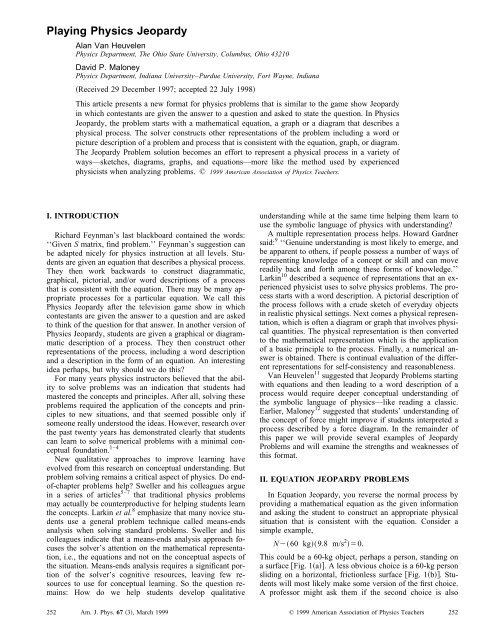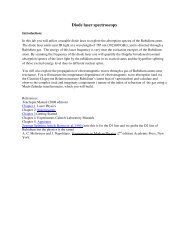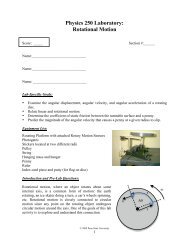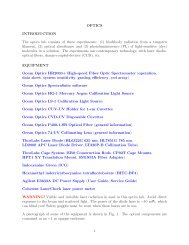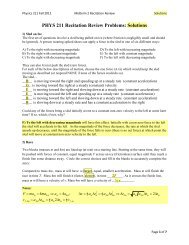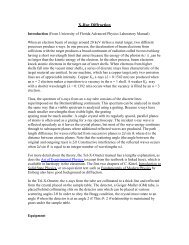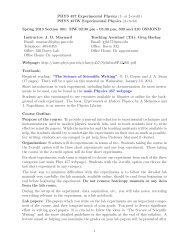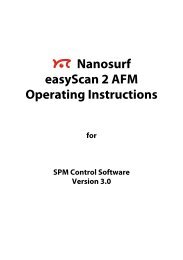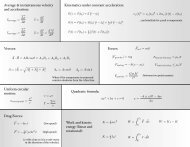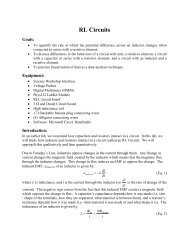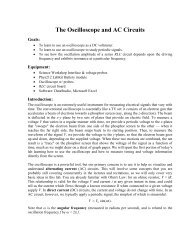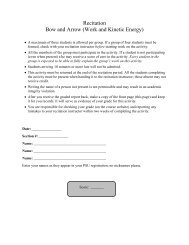Playing Physics Jeopardy
Playing Physics Jeopardy
Playing Physics Jeopardy
Create successful ePaper yourself
Turn your PDF publications into a flip-book with our unique Google optimized e-Paper software.
<strong>Playing</strong> <strong>Physics</strong> <strong>Jeopardy</strong><br />
Alan Van Heuvelen<br />
<strong>Physics</strong> Department, The Ohio State University, Columbus, Ohio 43210<br />
David P. Maloney<br />
<strong>Physics</strong> Department, Indiana University–Purdue University, Fort Wayne, Indiana<br />
Received 29 December 1997; accepted 22 July 1998<br />
This article presents a new format for physics problems that is similar to the game show <strong>Jeopardy</strong><br />
in which contestants are given the answer to a question and asked to state the question. In <strong>Physics</strong><br />
<strong>Jeopardy</strong>, the problem starts with a mathematical equation, a graph or a diagram that describes a<br />
physical process. The solver constructs other representations of the problem including a word or<br />
picture description of a problem and process that is consistent with the equation, graph, or diagram.<br />
The <strong>Jeopardy</strong> Problem solution becomes an effort to represent a physical process in a variety of<br />
ways—sketches, diagrams, graphs, and equations—more like the method used by experienced<br />
physicists when analyzing problems. © 1999 American Association of <strong>Physics</strong> Teachers.<br />
I. INTRODUCTION<br />
Richard Feynman’s last blackboard contained the words:<br />
‘‘Given S matrix, find problem.’’ Feynman’s suggestion can<br />
be adapted nicely for physics instruction at all levels. Students<br />
are given an equation that describes a physical process.<br />
They then work backwards to construct diagrammatic,<br />
graphical, pictorial, and/or word descriptions of a process<br />
that is consistent with the equation. There may be many appropriate<br />
processes for a particular equation. We call this<br />
<strong>Physics</strong> <strong>Jeopardy</strong> after the television game show in which<br />
contestants are given the answer to a question and are asked<br />
to think of the question for that answer. In another version of<br />
<strong>Physics</strong> <strong>Jeopardy</strong>, students are given a graphical or diagrammatic<br />
description of a process. They then construct other<br />
representations of the process, including a word description<br />
and a description in the form of an equation. An interesting<br />
idea perhaps, but why should we do this?<br />
For many years physics instructors believed that the ability<br />
to solve problems was an indication that students had<br />
mastered the concepts and principles. After all, solving these<br />
problems required the application of the concepts and principles<br />
to new situations, and that seemed possible only if<br />
someone really understood the ideas. However, research over<br />
the past twenty years has demonstrated clearly that students<br />
can learn to solve numerical problems with a minimal conceptual<br />
foundation. 1–4<br />
New qualitative approaches to improve learning have<br />
evolved from this research on conceptual understanding. But<br />
problem solving remains a critical aspect of physics. Do endof-chapter<br />
problems help? Sweller and his colleagues argue<br />
in a series of articles 5–7 that traditional physics problems<br />
may actually be counterproductive for helping students learn<br />
the concepts. Larkin et al. 8 emphasize that many novice students<br />
use a general problem technique called means-ends<br />
analysis when solving standard problems. Sweller and his<br />
colleagues indicate that a means-ends analysis approach focuses<br />
the solver’s attention on the mathematical representation,<br />
i.e., the equations and not on the conceptual aspects of<br />
the situation. Means-ends analysis requires a significant portion<br />
of the solver’s cognitive resources, leaving few resources<br />
to use for conceptual learning. So the question remains:<br />
How do we help students develop qualitative<br />
understanding while at the same time helping them learn to<br />
use the symbolic language of physics with understanding?<br />
A multiple representation process helps. Howard Gardner<br />
said: 9 ‘‘Genuine understanding is most likely to emerge, and<br />
be apparent to others, if people possess a number of ways of<br />
representing knowledge of a concept or skill and can move<br />
readily back and forth among these forms of knowledge.’’<br />
Larkin 10 described a sequence of representations that an experienced<br />
physicist uses to solve physics problems. The process<br />
starts with a word description. A pictorial description of<br />
the process follows with a crude sketch of everyday objects<br />
in realistic physical settings. Next comes a physical representation,<br />
which is often a diagram or graph that involves physical<br />
quantities. The physical representation is then converted<br />
to the mathematical representation which is the application<br />
of a basic principle to the process. Finally, a numerical answer<br />
is obtained. There is continual evaluation of the different<br />
representations for self-consistency and reasonableness.<br />
Van Heuvelen 11 suggested that <strong>Jeopardy</strong> Problems starting<br />
with equations and then leading to a word description of a<br />
process would require deeper conceptual understanding of<br />
the symbolic language of physics—like reading a classic.<br />
Earlier, Maloney 12 suggested that students’ understanding of<br />
the concept of force might improve if students interpreted a<br />
process described by a force diagram. In the remainder of<br />
this paper we will provide several examples of <strong>Jeopardy</strong><br />
Problems and will examine the strengths and weaknesses of<br />
this format.<br />
II. EQUATION JEOPARDY PROBLEMS<br />
In Equation <strong>Jeopardy</strong>, you reverse the normal process by<br />
providing a mathematical equation as the given information<br />
and asking the student to construct an appropriate physical<br />
situation that is consistent with the equation. Consider a<br />
simple example,<br />
N60 kg9.8 m/s 2 0.<br />
This could be a 60-kg object, perhaps a person, standing on<br />
a surface Fig. 1a. A less obvious choice is a 60-kg person<br />
sliding on a horizontal, frictionless surface Fig. 1b. Students<br />
will most likely make some version of the first choice.<br />
A professor might ask them if the second choice is also<br />
252 Am. J. Phys. 67 3, March 1999<br />
© 1999 American Association of <strong>Physics</strong> Teachers 252
volume must be 1.7810 3 m 3 or greater. The student must<br />
also think about units and conversions because the volume is<br />
given in the equation in m 3 , but the question asks for the<br />
volume in liters.<br />
Consider a <strong>Jeopardy</strong> Problem involving the component<br />
form of Newton’s second law applied to an object on an<br />
incline,<br />
Fig. 1. The equation N(60 kg)(9.8 m/s 2 )0 describes the situations<br />
shown in a and b.<br />
appropriate—an opportunity to confront a common student<br />
alternative belief.<br />
The first example is quite simple. More challenging <strong>Jeopardy</strong><br />
Problems can be created with relative ease. Take a standard<br />
problem and use a basic principle to write an equation<br />
that describes the problem process. Consider the following<br />
examples that represent either the description of a process at<br />
one instant of time or a continuous process with a beginning<br />
and an end the initial and final states of the process. An<br />
example of the latter is shown below with the left side of the<br />
equation representing the initial state and the right side the<br />
final state,<br />
1/26000 N/m2.00 m 2 72 kg9.8 m/s 2 17 m.<br />
The 1/2 times a number with units N/m times the square of a<br />
distance causes an experienced physicist to think of the elastic<br />
potential energy of a stretched or compressed spring. On<br />
the right side of the equation we have gravitational potential<br />
energy with a mass, the acceleration due to gravity and a<br />
distance height. If the left side is the initial energy and the<br />
right side the final energy, the process might involve an ejector<br />
seat with a compressed spring launching a 72-kg object<br />
another person upward a maximum distance of 17 m. There<br />
could of course be other processes described by the equation,<br />
such as a compressed spring launching the object up a frictionless<br />
incline so that the total change in elevation is 17 m.<br />
Students are encouraged to think divergently when inventing<br />
processes described by the equations.<br />
A <strong>Jeopardy</strong> Problem representing a steady state process is<br />
shown below:<br />
12 VI1/5 6 1/8 1 14 .<br />
The task here is to draw an electric circuit. Once again the<br />
student must translate a mathematical relation into a reasonable<br />
physical situation—in this case a diagram rather than a<br />
verbal statement.<br />
Consider a <strong>Jeopardy</strong> Problem that is followed by a series<br />
of questions to help students develop better conceptual understanding,<br />
1.39 kg9.8 m/s 2 <br />
780 kg/m 3 9.8 m/s 2 1.7810 3 m 3 0.<br />
After students decide that the equation describes an object<br />
floating in some liquid, which is not water, we might ask<br />
additional questions. What is the liquid? What is the volume<br />
of the floating object in liters? This latter question requires<br />
the student to realize that the 1.7810 3 m 3 in the right<br />
term of the equation is a lower limit for the volume of the<br />
object. The object would be in neutral buoyancy if immersed<br />
to its full volume and still ‘‘floating.’’ Since the 1.78<br />
10 3 m 3 is the lower limit for the object’s volume, the<br />
150 N14.5 kg9.8 m/s 2 sin 34°0.3214.5 kg<br />
9.8 m/s 2 cos 34°14.5 kga x .<br />
With a little work, a physicist will recognize that something<br />
exerts a 150-N force parallel to a 34° incline while pulling<br />
or pushing a 14.5-kg object up the incline. There is friction<br />
with a 0.32 kinetic friction coefficient between the object and<br />
the inclined surface. This <strong>Jeopardy</strong> Problem is somewhat<br />
more challenging. We can ask the students to translate from<br />
the mathematical representation to a physics sketch, a freebody<br />
diagram in this case, and then from the diagram to a<br />
picture-like sketch of an appropriate physical situation. Finally,<br />
students could be asked to invent a word problem that<br />
is consistent with the equation.<br />
<strong>Jeopardy</strong> Problems can be constructed for all physics subjects.<br />
For example, students might be given an application of<br />
the first law of thermodynamics (QUW) for an ideal<br />
gas, where W is the work done by the system:<br />
Q8.0 mol8.31 J/mol K361 Kln34.3 L/60 L.<br />
The students would either be asked to describe a physical<br />
process for which the equation applies or to answer a variety<br />
of questions such as the following. What type of process is<br />
this? How do you know? What are the volumes and pressures<br />
for the initial and final states of the process? What<br />
actually happened to the gas during the process? Did the gas<br />
do work during the process? Explain. By how much did the<br />
internal energy of the gas change during the process? Was<br />
there heat transfer to or from the gas?<br />
As another example, we might ask students to draw a<br />
sketch that represents a process described by the following<br />
equation suggested by F. Munley:<br />
1.510 6 N1.010 5 Cv0.010 T0.50.<br />
This could be the magnetic force exerted on a charged object<br />
moving at 30 m/s relative to a magnetic field. Why the 0.50<br />
at the end of the equation? The student needs to consider the<br />
relative directions of the magnetic field and the velocity.<br />
A more complex problem provides the coupled equations<br />
that result from the application of Newton’s law to a system<br />
of objects connected together by ropes and moving as one.<br />
Consider the equations below:<br />
T 1 0.1528 kg9.8 m/s 2 28 kga x ,<br />
T 2 T 1 0.1571 kg9.8 m/s 2 71 kga x ,<br />
T 3 T 2 0.1548 kg9.8 m/s 2 48 kga x .<br />
Similar multiple-equation problems can be constructed for<br />
many other physics concepts: systems of static electric<br />
charges; systems in static equilibrium; the application of<br />
Kirchhoff’s rules to an electric circuit; kinematics equations<br />
for multiobject systems a truck passing a car at a stop sign<br />
or a multipart single-object problem with different accelerations<br />
in each part for example, a bottle rocket’s vertical<br />
flight.<br />
253 Am. J. Phys., Vol. 67, No. 3, March 1999<br />
A. Van Heuvelen and D. P. Maloney 253
Fig. 2. The free-body diagram shown in a represents the process shown in<br />
b.<br />
III. DIAGRAM AND GRAPH JEOPARDY PROBLEMS<br />
In Diagrammatic and Graphical <strong>Jeopardy</strong> Problems, students<br />
are first given a diagram or graph. They then invent a<br />
word or picture description and a math description for a process<br />
that is consistent with the diagram or graph. Consider<br />
the force diagram in Fig. 2a. Tell as much about the situation<br />
as you can.<br />
The force diagram could describe a box or block moving<br />
downward at constant velocity along a vertical wall Fig.<br />
2b. The normal force indicates that the object is pressed<br />
against a vertical wall. The kinetic friction force indicates<br />
that the object is moving down. Notice that the y components<br />
of the forces parallel to the wall’s surface add to zero. This<br />
provides a nice opportunity to confront the common belief<br />
misconception that there must be a net force in the direction<br />
of motion in order for that motion to continue.<br />
In another problem, students are given a position-versustime<br />
graph Fig. 3. They then construct a motion diagram, a<br />
velocity-versus-time graph, and an acceleration-versus-time<br />
graph—all consistent with the position-versus-time graph.<br />
Finally, they invent a process that is consistent with all of<br />
these descriptions. Other types of <strong>Jeopardy</strong> Problems can<br />
start with a graph. For example, we might provide a graph of<br />
magnetic flux-versus-time or of the electric potential energy<br />
of a particle in an electric field as a function of time.<br />
Energy bar charts lend themselves nicely to this type of<br />
<strong>Jeopardy</strong> Problems. The bar chart shown in Fig. 4 indicates<br />
that the system starts with considerable elastic energy (U s )<br />
and ends with kinetic energy K and gravitational potential<br />
Fig. 3. Invent a process that is consistent with the kinematic position-vstime<br />
graph.<br />
Fig. 4. A qualitative work-energy bar chart—what’s the process?<br />
energy (U g ). One possible process would be a compressed<br />
spring that launches an object up an incline or straight up<br />
into the air. The object has some speed and kinetic energy at<br />
the final state of the process. Students must understand the<br />
meaning of the different types of energy in order to invent a<br />
process that is consistent with the bar chart.<br />
IV. SIMULATION JEOPARDY PROBLEMS<br />
All of these types of <strong>Jeopardy</strong> Problems can be used with<br />
simulations. For an Equation <strong>Jeopardy</strong> Problem, the student<br />
is first given an equation that describes a physical process.<br />
After students invent their own process, they can be shown a<br />
simulation that is one physical process that is consistent with<br />
the equation—there could be other processes. In a Graphical<br />
or Diagrammatic <strong>Jeopardy</strong> Problem, the student might see a<br />
kinematics graph or a work-energy bar chart that evolves<br />
with time on the simulation screen. The student then invents<br />
a process that is consistent with the graph or bar chart. Finally,<br />
a version of the simulation is run that shows one possible<br />
process that is consistent with the graph or bar chart.<br />
These types of activities can be produced with Interactive<br />
<strong>Physics</strong> 13 and are included in Activ<strong>Physics</strong>. 14<br />
V. STRENGTHS AND WEAKNESSES OF JEOPARDY<br />
PROBLEMS<br />
If one of our instructional goals is to promote problem<br />
solving with understanding, <strong>Jeopardy</strong> Problems have several<br />
strengths. First, students often think of traditional physics<br />
problem solving as a process for finding the right equation.<br />
For <strong>Jeopardy</strong> Problems, students cannot use formulacentered,<br />
plug-and-chug problem-solving methods. Instead,<br />
they must give meaning to the symbols in the equations and<br />
to the diagrams and graphs. They must visualize a process<br />
that is consistent with the equation, diagram, or graph. The<br />
equations, diagrams, and graphs become short stories about<br />
life. The mathematical relations in Equation <strong>Jeopardy</strong> Problems<br />
are models of physical situations rather than just something<br />
into which students plug numbers.<br />
A second strength of these problems is that units become<br />
more meaningful since they become the key to determining<br />
what physical quantities are involved. If we are dealing with<br />
the pressure in a standing fluid, then the quantities that will<br />
appear in one or more of the terms in the equation will be<br />
density, acceleration due to gravity, and a distance. The units<br />
are the key to recognizing each of these quantities. Consequently,<br />
the units become useful sources of information.<br />
254 Am. J. Phys., Vol. 67, No. 3, March 1999<br />
A. Van Heuvelen and D. P. Maloney 254
A third strength of these problems is that they help the<br />
students learn to translate between representations in a more<br />
robust manner. By robust we mean that they develop a stronger<br />
understanding of each representation—the verbal problem<br />
statement, the everyday picture-like representation, the<br />
physics representation, and the mathematical equation. They<br />
also learn to convert one representation into another and in<br />
any direction. To do this, each representation must have<br />
meaning for the student.<br />
A fourth strength of these problems is that they are easy to<br />
create. All you need is an existing problem from the back of<br />
the chapter of a physics book. Simply apply in equation form<br />
the fundamental principle needed to solve the problem. You<br />
have a <strong>Jeopardy</strong> Equation Problem. Or construct a diagram<br />
or graph that describes the problem. You have a <strong>Jeopardy</strong><br />
Diagram or Graph Problem.<br />
A fifth strength of <strong>Jeopardy</strong> Problems depends on their use<br />
in homework assignments and on tests. If students realize<br />
that <strong>Jeopardy</strong> Problems will appear on tests, the students are<br />
encouraged to think more deeply about standard end-ofchapter<br />
problems and to use multiple representations of<br />
physics processes to describe these problems.<br />
A weakness of <strong>Jeopardy</strong> Problems stems from the fact that<br />
they are novel for students. Any new problem format has<br />
some learning associated with it that is independent of the<br />
particular problem content. Students develop mechanisms for<br />
coping with free response, multiple choice, and essay questions<br />
on tests. They need practice with <strong>Jeopardy</strong> Problems<br />
before they are used on tests. It is important to start with<br />
relatively easy one-equation examples so students develop<br />
skill at solving such problems.<br />
There might also be concern about grading these problems.<br />
The authors find them easier to grade than standard<br />
problems presented in a free-response format. For <strong>Jeopardy</strong><br />
Problems, students present diagrams, graphs, bar charts, and<br />
sketches as part of the solution—seldom seen with traditional<br />
problems. The problems can even be presented in a<br />
multiple choice format by asking students to choose the one<br />
of five versions of one representation for example, five<br />
graphs that best matches the description of a situation in the<br />
form of another representation for example, an equation.<br />
VI. IMPACT ON STUDENT LEARNING<br />
The authors use one or more pedagogical innovations in<br />
their courses Active Learning Problem Sheets, Context-Rich<br />
Problems, Activ<strong>Physics</strong> interactive simulations, Ranking<br />
Tasks, and <strong>Jeopardy</strong> Problems. It is difficult to say what<br />
impact any one of these innovations has on student learning<br />
as measured by various types of tests. The widely used Mechanics<br />
Baseline Test MBT, a problem-solving test with a<br />
strong conceptual base, might be one of the better measures<br />
of students’ ability to use the math language of physics with<br />
understanding—a main goal for using <strong>Jeopardy</strong> Problems.<br />
During the last two years, one author AVH has taught<br />
calculus-ready freshmen engineers—honors students in their<br />
engineering course. <strong>Jeopardy</strong> Problems were used routinely<br />
on their tests. They scored 78 on the MBT during the winter<br />
of 1997 and 77 during the fall 1997. These scores are equal<br />
to and perhaps slightly higher than the best scores reported<br />
by Hake for 3259 students from different colleges, including<br />
a prestigious Ivy League university. 15 The fall 1997 class<br />
scored 86 on the Force Concept Inventory Test, a qualitative<br />
reasoning test concerning mechanics. Representing physical<br />
processes in multiple ways, including the use of <strong>Jeopardy</strong><br />
Problems, we believe has a very positive effect on students’<br />
ability to use the math language of physics with understanding.<br />
What do students say about <strong>Jeopardy</strong> Problems? One of us<br />
DVM has used <strong>Jeopardy</strong> Problems as homework assignments<br />
in a calculus-based introductory physics course. At the<br />
end of each semester, he asks students to identify the five<br />
homework assignments from which they learned the most<br />
and the five assignments from which they learned the least,<br />
and to explain why. One class was also asked to identify the<br />
advantages and disadvantages of each problem type. <strong>Jeopardy</strong><br />
Problems were identified as difficult. Several student<br />
comments follow:<br />
‘‘The advantage of this type of homework was the use<br />
of looking at equations and seeing how they apply in<br />
the real world.’’<br />
‘‘I spent a very long time on this one, repeated it over<br />
and over. I think because it gave the force equations and<br />
ask to draw free body diagrams and a physical situation<br />
it forced me to analyze the equations until I knew exactly<br />
what everything meant.’’<br />
‘‘Even though I hated this one, it made me think ... a<br />
lot. Instead of just giving me the situation and asking<br />
me to find the answer, you turned the tables and had me<br />
work through the situation the opposite way I normally<br />
would have. I had to use the equations and come up<br />
with a reasonable physical situation and this was you<br />
could say rather ‘stimulating.’ ’’<br />
Learning to read with understanding the equations of physics<br />
is a challenging task for our students and a task that is not<br />
addressed by typical end-of-chapter problems.<br />
VII. SUMMARY AND CONCLUSION<br />
This article has presented a new format for physics problems.<br />
The format essentially reverses the usual solution sequence<br />
by providing the mathematical equation as the starting<br />
point, normally the next to last point of the solution<br />
process. Solvers then construct from the equation one, or<br />
more, of the following: a physics representation, an everyday<br />
picture-like representation, or a verbal description of the<br />
physical situation. Other versions of <strong>Jeopardy</strong> Problems start<br />
with diagrams, graphs, or bar charts. A wide variety of problems<br />
can be developed using this format. These problems<br />
range in difficulty from reasonably straightforward to very<br />
complex. The format is useful in all topic domains of physics<br />
and at all levels of physics—remember Feynman’s S-matrix<br />
problem.<br />
The value of this problem format is that it helps students<br />
develop a new perspective for both the problem-solving process<br />
and for the use of different representations to model<br />
physical processes. The equation description of a process is<br />
now regarded more as a short story about some aspect of<br />
life—about a physical process—and less as a set of symbols<br />
that must be solved numerically to answer a question. The<br />
problem solution becomes an effort to represent a physical<br />
process in a variety of ways—sketches, diagrams, graphs,<br />
and equations—more like the method used by experienced<br />
physicists when analyzing problems. <strong>Jeopardy</strong> Problems help<br />
students develop a better understanding and appreciation for<br />
the representations needed to solve problems with understanding.<br />
255 Am. J. Phys., Vol. 67, No. 3, March 1999<br />
A. Van Heuvelen and D. P. Maloney 255
1 J. Clement, ‘‘Students’ Preconceptions in Introductory Mechanics,’’ Am.<br />
J. Phys. 50, 66–71 1982.<br />
2 I. A. Halloun and D. Hestenes, ‘‘The Initial Knowledge State of College<br />
<strong>Physics</strong> Students,’’ Am. J. Phys. 53, 1043–1055 1985.<br />
3 P. C. Peters, ‘‘Even Honors Students Have Conceptual Difficulties with<br />
<strong>Physics</strong>,’’ Am. J. Phys. 50, 501–508 1982.<br />
4 L. C. McDermott, ‘‘Millikan Lecture 1990: What we teach and what is<br />
learned—closing the gap,’’ Am. J. Phys. 59, 301–315 1991.<br />
5 J. Sweller, R. F. Mawer, and M. R. Ward, ‘‘Development of Expertise in<br />
Mathematical Problem Solving,’’ J. Exp. Psychol. 112, 639–661 1983.<br />
6 J. Sweller, ‘‘Cognitive Load During Problem Solving: Effects on Learning,’’<br />
Cogn. Sci. 12, 251–285 1988.<br />
7 M. Ward and J. Sweller, ‘‘Structuring Effective Worked Examples,’’<br />
Cogn. Instruc. 7, 1–39 1990.<br />
8 J. H. Larkin, J. McDermott, D. P. Simon, and H. A. Simon, ‘‘Expert and<br />
Novice Performance in Solving <strong>Physics</strong> Problems’’ Science 208, 1335–<br />
1342 1980.<br />
9 H. Gardner, The Unschooled Mind: How Children Think and How Schools<br />
Should Teach Basic Books, New York, 1991, p.13.<br />
10 J. Larkin, ‘‘The Role of Problem Representations in <strong>Physics</strong>,’’ in Mental<br />
Models, edited by D. Genther and A. L. Stevens Erlbaum Associates,<br />
Hillsdale, NJ, 1983.<br />
11 A. Van Heuvelen, ‘‘ ‘What’s the Problem?’ Problems,’’ Announcer 23, 80<br />
1993.<br />
12 D. P. Maloney, ‘‘Forces as Interactions,’’ Phys. Teach. 28, 386–390<br />
1990.<br />
13 Knowledge Revolution, Interactive <strong>Physics</strong> 3.0, San Mateo, CA 1996.<br />
14 A. Van Heuvelen, Activ<strong>Physics</strong> 1 Addison–Wesley, Menlo Park, CA,<br />
1997.<br />
15 Richard R. Hake, ‘‘Interactive-engagement versus traditional methods: A<br />
six-thousand student survey of mechanics test data for introductory physics<br />
courses,’’ Am. J. Phys. 66, 64–74 1998.<br />
PITY THE POOR OBSERVER<br />
My search consisted mainly of concerning any physicist I chanced to meet at a cocktail party<br />
and asking, ‘‘Why is it so important to know the exact speed of light?’’<br />
Most of the answers only puzzled me. One was that the speed of light is one of the few<br />
‘‘constants’’ in nature, unaffected by the motion of the source of light or that of the observer.<br />
What observer, I wondered. I was to hear a lot about this unfortunate creature before I had<br />
finished. He was forever on board a train, going toward nowhere in particular, and never even<br />
allowed to comment upon the phenomena he observed. Aristotle stood him on the earth, Copernicus<br />
and Kepler put him up in the sky, and Einstein had him locked in an elevator, plunging down<br />
an endless shaft.<br />
Dorothy Michelson Livingston, The Master of Light—A Biography of Albert A. Michelson The University of Chicago<br />
Press, Chicago, 1973, pp. 5–6.<br />
256 Am. J. Phys., Vol. 67, No. 3, March 1999<br />
A. Van Heuvelen and D. P. Maloney 256


